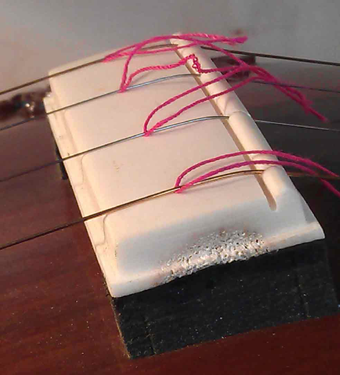Tuning the tanpura 2
“The students of a great dhrupad singer were having difficulties tuning the second tanpura, so they asked the master himself to help them. He took the tanpura and to everyone's visible amazement tuned it very nicely "out of tune"!! The students were then told to play both tanpuras, one of which was in tune, the other slightly, but defiantly out of tune. The master proceeded to sing and after some time he stopped to check the tuning of the tanpuras, and to his satisfaction, they were both found to be in tune! “
The vibrations of one tanpura had clearly affected that of the other, pulling them into a similar pitch. Scientifically speaking this is called "nonlinear oscillator synchronization" and is a process that is frequently encountered in nature. Rupert Sheldrake, an eminent British scientist might claim this to be an effect of what he would call "morphic resonance"; the way energy fields of vibration may affect each other.
Clearly, the human being has a lot to learn about sound, and there are many more factors involved in tuning than one imagines. We should do our best to tune as precisely as possible and sometimes have to just "trust in God"! However, the further one progresses in tuning, the finer and more precise one's hearing becomes. It's a development most musicians encounter and this makes the tuning process easier.

Adjusting the threads, Jiva
Once the strings are tuned, one then has to adjust the jiva. This is the process to achieve the correct buzz and production of overtones. Take a thin thread used for a sewing machine. Place this thread between the string and the bridge. By playing the string and then slowly pulling the jiva further up the bridge whilst the string is still vibrating, one will suddenly find a spot on the bridge where the buzz gets far stronger. This spot, or very close by this spot is the position of the jiva. Subtly, minutely pull the jiva around this position until the best sound is found. If it doesn’t work, try again. It is common to have a few attempts before one is satisfied with the rising amount of overtones combined with the strength of the strings buzz. Take your time because if this part of the tuning is not good then you will probably be disturbed in your playing.
I use sewing machine thread for the jiva. Selecting the correct thickness is very important. This depends on the string tension and the shape of the bridge. I often start by using the thinnest thread, which unfortunately may break more often. I then try thicker and thicker until the required sound and durability is produced. One needs steady, stable overtones with as much sustain as possible. After some time the thread will become flattened under the constant hammering from the vibrating string, thus losing its optimal sound. Be sure to use a different position of the thread before placing it under the string to avoid this problem.
